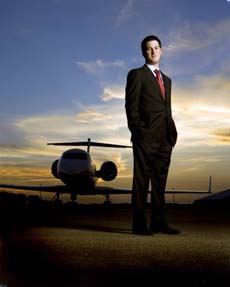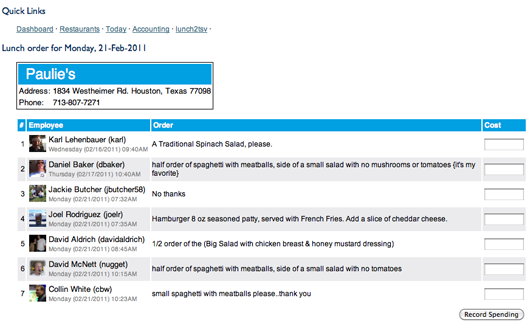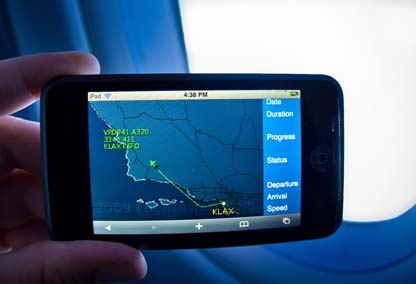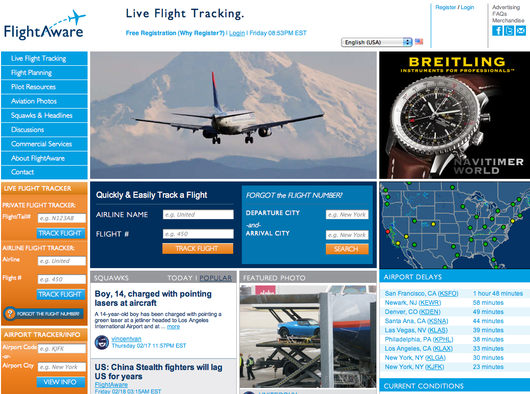 In late 2004, Daniel Baker (right) was a newly minted private pilot flying Cessna 172s around the country. “I wanted my friends and family to be able to track my flights just as they could if I were flying on a commercial airline,” explains Baker. “I may have been piloting the aircraft myself, but I still needed a ride once I landed. There were a few commercial products that provided this service for around $1,000 a month, but that wasn’t a realistic solution for friends and family. I got in touch with the FAA and after learning a bit about working with the government, managed to obtain a feed of the live flight data.”
In late 2004, Daniel Baker (right) was a newly minted private pilot flying Cessna 172s around the country. “I wanted my friends and family to be able to track my flights just as they could if I were flying on a commercial airline,” explains Baker. “I may have been piloting the aircraft myself, but I still needed a ride once I landed. There were a few commercial products that provided this service for around $1,000 a month, but that wasn’t a realistic solution for friends and family. I got in touch with the FAA and after learning a bit about working with the government, managed to obtain a feed of the live flight data.”
Baker then started working during his free time to build an infrastructure for processing the data and a web interface. He recruited friends Karl Lehenbauer and David McNett to help out too. After six months they released FlightAware.com to the public. The site “took off like wildfire” within the pilot community, according to Baker.
“Before long, the phone started ringing,” he says. “A guy called asking for a data report. I was so excited that someone was interested in us that I produced an Excel file for him for free. The next day, someone called asking for a similar project and I charged him $200, which he gladly paid. Later that day, another call, and I charged $500, which was no problem. It didn’t take long to realize that we had stumbled into a real business. It also didn’t take long for the call volume to encourage me to hire someone to answer the phone.”
The rapid growth led to hardware and bandwidth expenses. At first, Baker used his credit card to cover the costs. He says, “Initially, I bought a server for $6K and just put it on my AmEx. I figured it would all work out; I did the math and at our October 2005 run rate of $20/day, I’d be able to pay myself back in just under a year. I was OK with that. Quickly, it became clear that we were going to grow a little faster than that and we all chipped in for more hardware, some graphic design, and bandwidth. All in all, we only fronted about $25K before we broke even in March of 2006. And we have been profitable ever since then.”
The inside scoop on flights
Now, the site is a full fledged hit. Unlike airline-centric sites that simply pass on the flight status straight from the airlines, FlightAware.com shows the real-time, inside scoop from air traffic control data and other operational data sources. This includes radar positions, flight plan re-routes, and weather on interactive maps, delay projections, trends, and more. According to Baker, the site serves over two million people per month, split about 50/50 between airline and private flights. It displays over 150M ads every month.
Additional revenue comes from commercial data services. Baker explains, “Everything from a single aircraft owner who needs a flight history report to complete their taxes, to aircraft engine manufacturers who want to evaluate real-world flight conditions. There are many valuable answers to be found within FlightAware’s historical databases, and there are many organizations that have interesting questions.” FlightAware also profits from enterprise products for the aviation industry.
FlightAware did over a million dollars in the first 18 months after it launched, according to Baker. “It’s pretty remarkable considering we had no business strategy or real products back then,” he says. “Now, sales are in the millions, we continue to grow revenue 40-75% a year, we’ve got over 20 employees and offices in two cities (Houston, New York) and three data centers (Houston, New York, London). We think it’s a rate we can sustain for several years before we need to expand the strategy.”
“It’s pretty remarkable considering we had no business strategy.”
Not your typical dot com
A young internet company means everyone rolls in at noon, plays ping pong, and wears shorts, right? Not at FlightAware. “We start answering the phones at 7am on weekdays — we’re open 7 days a week, by the way. Almost everyone is in by 9am, and we dress up,” says Baker. “Unlike a lot of ‘dot coms,’ we’re involved in decision-making for aircraft operations, crew scheduling, and travel plans. Our customers don’t have any sense of humor about outages, delayed data, or missing deadlines on custom projects. Accordingly, we try to act more like an enterprise services business — we’re maniacs about monitoring, redundancy, and we definitely don’t use a clever error page with a cartoon.

“However, that doesn’t mean that we’re slow moving, have a stifling bureaucracy, or that we don’t have any fun. Every employee is empowered to improve or change anything — from changing a process to pushing to get a feature onto the web site. Developers’ changes to the code are live to the world in less than 24 hours.
“It’s rewarding to see your work in production and used by millions of people so rapidly. Developers have hobby projects that usually make it into production or lead to something like our web-based system for ordering lunch and the status of the coffee machine being displayed for employees at the top of every web page if the coffee’s fresh.

This “hobby project,” dubbed LunchAware, offers voting on restaurants, order cut-off times, random orders or your standard order from a particular restaurant, reminders if you haven’t placed an order, direct debit from your pay check, etc.
“On the sales side, everyone can pretty much come up with their own strategy, market, or even product, if people will actually buy it and we can reliably deliver it. Our sales team doesn’t just sell FlightAware’s products and services; they also invent and design them.
“Matt Davis from our sales team realized we could combine a bunch of different features and data and sell it to FBOs, terminals for private jets. He named it FBO Toolbox and he sells it for $100/month (competitive products are around $1K/month). He convinced one of our developers to put a few hours into it every now and then and now we’ve sold hundreds of licenses in the 14 months since the product launch. It does fuel price trending and figures out how much fuel an inbound aircraft needs and all sorts of amazing stuff. There was no official company initiative to make that happen and the CTO and I have had no involvement. He recently asked if he could get our creative design firm to make a brochure (PDF) for it and I agreed; I was amazed to see how many features it has! Pretty cool.”
Growing pains
As for growing pains, Baker says the toughest part has been turning employees from doers into managers. “FlightAware, like a lot of companies, started out with people who are ‘rock stars’ at their particular niche,” he says. “The rock star developer, the rock star database architect, the rock star biz guy, etc. That’s how we created a killer product so fast, got millions of users, tons of press, thousands of customers.
Do something that you want to do, business and money aside. Do something that you would do for free because you think it’s such a cool idea.
It’s very common for people to give me lots of credit for my “incredible market insight” and “exploiting a niche” — but it was none of that. I wanted to do flight tracking and I was really excited about it. The reason we’re successful is because there was fanatical passion driving the development. All that passion resulted in something that people really enjoy using and now it’s not just the employees who love FlightAware — the customers do too. If the only reason you’re making something is to turn a profit or flip it, that will show in your product.
Of course, it sure didn’t hurt that it was a good idea, ultimately, and that people really wanted it. That said, I think that lots of businesses fail due to a lack of passion and drive as often as they fail because the business was a bad idea from the start.
“Then, the company grew into a real business with a corporate structure, and the original ‘rock star’ guys suddenly had to become managers of employees and worry about various project deadlines. It makes sense and it’s a natural way to grow, but then we realized that we had our ‘rock star’ people in key positions where their primary job is not their core competency.
“That continues to be a real learning experience for everyone; It requires a lot of growth, self-reflection, and personal motivation to excel at something that isn’t your strength. The key is that you have to want to be a great manager — even if you’d rather be doing something else — because you’re committed to moving the company forward.
“I use myself as an example a lot. Every day I’m doing something I’ve never done before. I’ve never been the CEO of a 6 year old company. I’ve been the CEO of FlightAware as a 1, 2, 3, 4, 5 year old company — so I’ve done that — but every day I’m running a company that’s larger than any other company I’ve run before.”
Exit strategy?
One thing Baker fights against is being a slave to customer requests. He says, “Customers — or prospective customers — will often say, ‘If you just build X, I would buy it and you could sell it to everyone.’ And it’s really tempting to go and make that product. However, I’ve been burned by that both at FlightAware and at previous companies. The problem is that people don’t actually know what they want until it exists. It’s not that customers are stupid or something, because I’m the same way; I’ll regularly demand that a feature should work one way and then when I see it, I realize it doesn’t actually make sense or wasn’t as good an idea as I originally thought.”

FlightAware comes to an iPhone.
Baker’s goal is to be the largest and most reliable source of aviation data and services powering everything from airport displays to airline dispatch tools to iPhones. As for an exit strategy, he says, “That’s not something I really think about. I’m not saying it makes sense for me to run and grow FlightAware for the next 50 years, but I don’t think anyone can be successful by constantly thinking about a sale, acquisition, IPO, whatever. The potential buyer is not using the product everyday and we didn’t create the products or the company for them.”
“I don’t think anyone can be successful by constantly thinking about a sale or IPO.”
Visit FlightAware.com
This is part of our “Bootstrapped, Profitable, & Proud” series which profiles companies that have over one million dollars in revenues, didn’t take VC, and are profitable.


Miyuru
on 25 Feb 11Hi, I am an aviation blogger. So from the same field. I use flightaware often. You seem to follow the same principles of Getting Real. Kudos, keep it up !
Anonymous Coward
on 25 Feb 11Am I the only person who doesn’t understand the value of this service.
Nor, am I the only person who cannot find on FlightAware.com web site how they make money.
kllred
on 25 Feb 11Nice work in setting an example for how new businesses literally get off the ground.
Shubham
on 25 Feb 11Really great and inspiring story Daniel.
As mentioned the first people you hired were your friends. My question is that do you think it’s a good idea to take your idea to friends or family first and see if you can get any help? Or should one actually go look for people outside our acquaintance and trust them with their skills?
I have heard different views on both sides but just wanted to know what you think about it.
Daniel Baker
on 25 Feb 11Although I don’t have any experience working with family, I think that involving friends (especially those that you have worked with in the past) is a great way to do it.
When your business is merely an idea with no funding, it’s not realistic to recruite good people you don’t know to work on your project unless you’re willing to make (or find) a significant financial investment. Even then, how do you know that these people (who need to be instrumental in executing on your idea) share your same values and if they will be compatible with your style and work ethic? And how do you trust the advice they give you? It’s not impossible, but it doesn’t sound very easy.
With friends, you will ultimately face challenges when “friends working on a hobby” turn into “partners in a business,” but as long as you have the same goals, the growth will be mutual.
Keep in mind that my recommendation extends to friends that you’ve worked with and that have a skill set that is important for your idea. I don’t think that just because you’re really good friends with someone is, in itself, a qualification that makes a business relationship appropriate.
Mimi
on 25 Feb 11I personally love to use FlightAware when any of my family travels. I’ve been telling my friends about it that fly and they like it a lot also. It is so easy to use and actually fun! This article is really good describing how you got started. I’m especially impressed with MD coming up with the great idea of Toolbox for FBO’s. You obviously have some very creative and intelligent people working there. Thanks for a great website!
Hutch
on 25 Feb 11How did you approach the FAA to get flight data? Where does the flight data come from exactly and in what format? What language is flight aware built on? What DB type do you use?
FredS
on 25 Feb 11You’ve made college football coaching changes (and speculation) very interesting… and for that, I thank you.
Daniel Baker
on 25 Feb 11@Hutch I called them and it didn’t go well initially. Virtually all information from the FAA (and the rest of the government is public), but it was required that I run a T1 to Boston, etc, so it wasn’t exactly turn-key. FlightAware originally got it from a private company that was already receiving (and not really using) the data before we could afford to get a direct connection.
Although we have over a dozen flight data sources now, the FAA’s flight data is from the air traffic controls system and is essentially a looking glass into the national airspace. It was a streaming text format (space delimited) and is now a streaming binary XML feed.
For info on the platform/language/database, see our code page with our open source initiative and information about our infrastructure.
Arvind
on 27 Feb 11This work is definitely awesome, as now I can see where my family is on earth exactly. I do see the project as simply the beginning of exploring the possible use-cases about real-time flight data. For example, now we can move the black-box away from the aircraft to some place remote. Allow update of mid-flight aircraft health, fuel status and so on.
Great work. Keep it up.
Josh
on 27 Feb 11I love FlightAware and I’m glad they’re experiencing such growth. I’m a photographer/spotter and regularly use FlightAware to see what types of planes are coming to the local airports and when. It has allowed me to build a portfolio of rather rare planes that I would otherwise possibly miss. My favorite part is probably the e-mail alerts system, which is absolutely fantastic. Right now the only want the site has left me is for them to release an Android version of their mobile app.
Dave
on 28 Feb 11Daniel, very inspiring story. Kudos to you and your team for creating such a valued service. My questions comes from something you said about your engineers. You mention that some of your Rock Star engineers have to become managers even though they may not want to in order for the company to grow. Why is that? Have you considered allowing them to continue as Rock Star engineers and bring in Rock Star managers?
Ecommerce
on 28 Feb 11Its great to see people with vision and drive especially during times of economic struggle. I wish you all the best and am sure you will go from strength to strength in the future.
Yosep
on 28 Feb 11Thanks for the great article, Daniel. I’ve always wanted to run my own business, and I think I am very close to starting one soon. Nevertheless, I am always interested in keeping employee happy and motivated. Unlike other companies that were previously interviewed here, your company is a non-dot-com company as far as company “culture” concerns. So, what are perks and cool things your company provide for your employees? I would appreciate it if you could share with us how you are giving back to employees while making a lot more money year after year. Thank you!
Daniel Baker
on 28 Feb 11@Dave—I agree that the ultimate goal is, across the board, is to have people doing what they’re best at. However, that’s easier said than done. When you’re growing on revenue, you use your money to hire people who can contribute the most as quickly as possible, even if it means other people have to pick up the slack. As a result, founders wear a lot of hats initially.
If you make a list of the important roles/positions of a small company, there are probably dozens, but you can’t have a 7 person company and then go hire a project manager, an accounts manager (to deal with customers after sales people sell an account), an accountant, an office manager, operations engineers to keep things running, a vendor/contracts manager, a compliance officer, and more. Those are shared responsibilities to move the company forward. For companies with VC, they take the opposite approach.
Daniel Baker
on 28 Feb 11@Yosep—I think the things that truly make employees happy are more along the lines of being personally valued, working with fun and smart people, being able to participate in creating something great, having an impact on the world, working with an organized team, being confident that your role is productive, being confident that the employer isn’t going to go out of business, a comfortable office environment, and more.
We have all that.
We have full benefits of course (insurance, matching 401k, weeks of paid time off, etc) and some perks like a kitchen stocked with free snacks/drinks/etc, convenience like ordering lunch directly paid out of your check, happy hours, company parties, etc. But I don’t think anyone would stick around at a boring, frustrating, disorganized company because of that.
David Andersen
on 28 Feb 11The best BPP yet. I’m guessing you guys have already seen that this is the foundation for a great book?
Daniel, your comments about managers are insightful. And the nod to organization being a key element is also something I rarely hear but notice its impact dramatically at my customers.
Tim
on 03 Mar 11Oh man, I didn’t even know this existed, and I need this service for one of my sites (was contemplating looking into something like this).
You guys have saved me a lot of work and $.
Rock and roll, and great work and congrats!
Tim
Flying Tigers Group
on 04 Mar 11We’ve been using Flightaware at our website for years to look up flight schedules, etc. Love what you guys do, great stuff.
This discussion is closed.